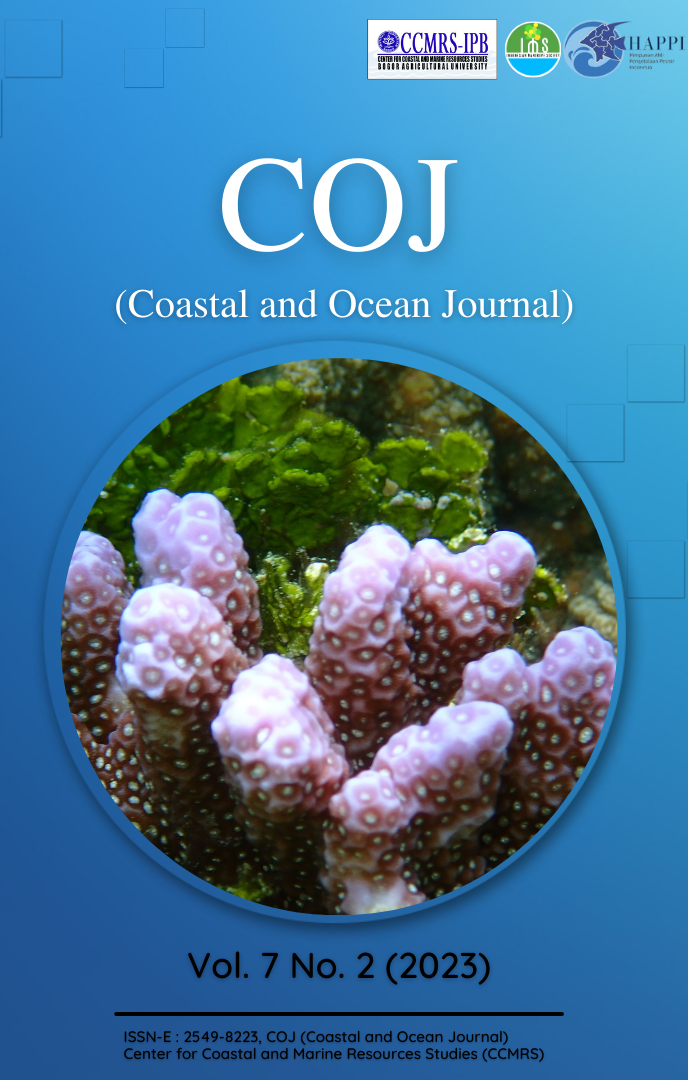PERCEPTIONS OF PURSE SEINE SHIP FISHERMAN TOWARDS RESPONSIBLE CAPTURE FISHERIES AT PT. PT HASIL LAUT SEJATI BATAM CITY
DOI:
https://doi.org/10.29244/coj.v7i2.50031Keywords:
Industrial fishermen, code of conduct for responsible fisheries, fisheries management, fishermen's perceptions.Abstract
The perception of fishermen regarding responsible capture fisheries based on the CCRF is of utmost importance. Guidelines for responsible fishing provide a framework for both national and international efforts to ensure the sustainable and responsible utilization of marine resources. The objective of this research is to understand the socio-economic characteristics and perceptions of purse seine fishermen at PT. Hasil Laut Sejati in Batam City regarding responsible fishing practices. The required data for this research includes both primary and secondary data sources. Primary data collection involves direct observations and interviews with fishermen. Secondary data for this research is obtained from reports from relevant agencies, journals, and research reports. The analysis of fishermen's perceptions of responsible capture fisheries is conducted using a Likert scale. The socio-economic characteristics of PT. Hasil Laut Sejati's fishermen in Batam City show that 60% have completed high school education, and the age of fishermen ranges from 20 to 30 years. In terms of economic characteristics, fishermen have an average income of 3 million per month. The fishermen's perceptions (Captain, Chief Mate, and Crew) indicate strong agreement with responsible capture fisheries, with 28% strongly agreeing, 45% agreeing, 23% disagreeing, and 3% strongly disagreeing.
Downloads
References
Bungin, B. (2011). Metode Penelitian Kuantitatif. Jakarta (ID): Prenada Media.
Donkó. (2008). PIC Simulaton of The Separate Control of In Flux and Energy in CCRF Discharger via The Electerial Asymmetry Effect” Journal of Physics D: Applied Physics.
Ernita, M. (2016). Persepsi Nelayan Pancing Tonda Terhadap Perikanan Tangkap Yang Bertanggung Jawab di Pelabuhan Perikanan Nusantara Palabuhanratu.[skripsi]. Bogor (ID)Institut Pertanian Bogor.
Hernadi. (2017). Alat Penangkapan Ikan yang Ramah Lingkungan Berbasis Code of Conduct For Responsible Fisheries di Kota Banda Aceh. Jurnal Agrisep, 15:12.
Ningsih, F. S., Cahyadinata, I., & Irnad, I. (2017). Kajian Persepsi Nelayan Terhadaap Kebijakan Perikanan Di Kota Bengkulu. Jurnal Agrisep: Kajian Masalah Sosial Ekonomi Pertanian Dan Agribisnis, 16(2), 133–144.
Partadisastra, M. A. 2015. Persepsi Nelayan Pelabuhan Perikanan Muara Angke, Jakarta Utara Terhadap Code of Conduct for Responsible Fisheries(CCRF). Tesis. Program Pascasarjana Universitas Terbuka. Jakarta.
Riyanda, R., & Haadi, F. (2018). Strategi Dinas Perikanan Kota Batam Dalam Mengoptmalisasi Kesejahteraan Masyarakat Nelayan. Jurnal Dialektika Publik. 3(1), 31-38.
Subekti, I. (2010). Implikasi Pengelolaan Sumberdaya Perikanan Laut di Indonesia Berlandaskan Code of Conduct for Responsible Fisheries (CCRF). Jurnal Ilmiah Ilmu Hukum QISTI. 4(1): 38-51.




